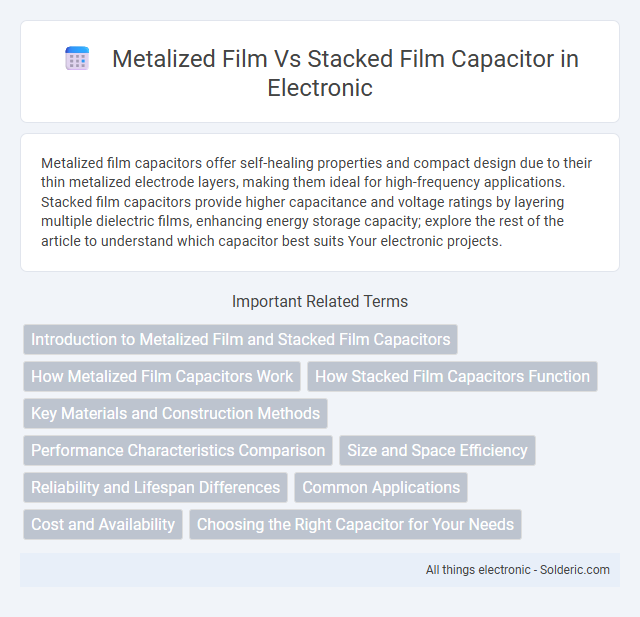Metalized film capacitors offer self-healing properties and compact design due to their thin metalized electrode layers, making them ideal for high-frequency applications. Stacked film capacitors provide higher capacitance and voltage ratings by layering multiple dielectric films, enhancing energy storage capacity; explore the rest of the article to understand which capacitor best suits Your electronic projects.
Comparison Table
| Feature | Metalized Film Capacitor | Stacked Film Capacitor |
|---|---|---|
| Construction | Single-film with metalized layer | Multiple film layers stacked and laminated |
| Capacitance Range | Low to medium (pF to uF) | Medium to high (nF to uF) |
| Voltage Rating | Up to 1000V | Up to 2500V or higher |
| Size | Compact and thin | Larger due to stacking |
| Reliability | Self-healing property, less durable under high stress | Higher durability and stability |
| Application | General electronics, filtering, decoupling | Power electronics, high voltage circuits |
| Cost | Lower cost | Higher cost |
Introduction to Metalized Film and Stacked Film Capacitors
Metalized film capacitors feature a thin metal layer deposited directly onto a plastic film, offering self-healing properties and compact design ideal for high-frequency applications. Stacked film capacitors consist of multiple film layers stacked and internally connected to increase capacitance and voltage ratings, providing stable performance in power circuits. Your choice depends on the application's voltage requirements, size constraints, and dielectric stability preferences.
How Metalized Film Capacitors Work
Metalized film capacitors function by depositing a thin metal layer directly onto a plastic film, creating a self-healing electrode that improves reliability and longevity. When a dielectric breakdown occurs, the metal layer around the fault evaporates, isolating the defect and allowing the capacitor to maintain performance. This self-healing property makes metalized film capacitors highly suitable for applications requiring stability and durability, enhancing your circuit's efficiency.
How Stacked Film Capacitors Function
Stacked film capacitors function by layering multiple dielectric films and electrode plates in a compact stack, increasing capacitance without enlarging the capacitor size. Each dielectric layer is metalized or metallized, allowing charge storage across the surface area and enhancing voltage endurance. This structure results in improved energy density and better thermal stability compared to single-layer metalized film capacitors.
Key Materials and Construction Methods
Metalized film capacitors utilize a thin layer of metal deposited directly onto a plastic film, creating a self-healing electrode that enhances reliability and reduces size. Stacked film capacitors consist of multiple layers of plastic film and metal foil stacked and laminated together, providing improved capacitance and voltage ratings by increasing the effective electrode surface area. Your choice depends on the desired electrical performance and durability, as metalized films offer compactness and self-repair, while stacked designs deliver higher stability under stress.
Performance Characteristics Comparison
Metalized film capacitors offer self-healing properties, higher voltage ratings, and longer lifespans due to their thin metalized electrodes, optimizing reliability under high-voltage stress. Stacked film capacitors provide increased capacitance density and improved temperature stability by layering multiple film elements, enhancing performance in compact design applications. Both types exhibit low equivalent series resistance (ESR), but metalized film capacitors excel in energy efficiency, while stacked film capacitors deliver better mechanical robustness.
Size and Space Efficiency
Metalized film capacitors offer superior size and space efficiency due to their thin dielectric layers and self-healing properties, allowing more capacitance in a smaller volume. Stacked film capacitors, while generally larger and thicker, provide higher voltage ratings and capacitance by layering multiple film sections but occupy more PCB space. Design engineers often prefer metalized film capacitors for compact electronic devices where minimizing size is critical.
Reliability and Lifespan Differences
Metalized film capacitors offer superior self-healing properties, enhancing reliability by automatically repairing minor dielectric damages, which extends their operational lifespan in high-stress environments. Stacked film capacitors, while providing higher capacitance values, may experience reduced reliability due to potential delamination and increased dielectric stress over time. Your choice between the two should consider the specific application's tolerance for lifespan and failure rates, with metalized film capacitors generally preferred for long-term durability.
Common Applications
Metalized film capacitors are widely used in filtering, coupling, and decoupling applications within power supplies, audio equipment, and signal processing due to their self-healing properties and compact size. Stacked film capacitors excel in applications requiring high capacitance and voltage ratings, such as energy storage in power electronics, pulse applications, and DC-link smoothing in inverters. Your choice between these types depends on the specific electrical requirements and space constraints of the application.
Cost and Availability
Metalized film capacitors generally offer lower cost and higher availability due to their widespread manufacturing and simpler construction. Stacked film capacitors tend to have higher prices reflecting their advanced design, which provides improved electrical performance but limits mass production scale. Availability of stacked film capacitors is more restricted to specialized suppliers, while metalized film capacitors are commonly stocked by major electronic component distributors.
Choosing the Right Capacitor for Your Needs
Metalized film capacitors offer self-healing properties and compact design, ideal for applications requiring reliability and space efficiency. Stacked film capacitors provide higher capacitance and voltage ratings, suitable for power electronics demanding robust performance. Selecting the right capacitor depends on balancing factors like capacitance value, voltage rating, size constraints, and application-specific requirements.
Metalized film vs stacked film capacitor Infographic

 solderic.com
solderic.com